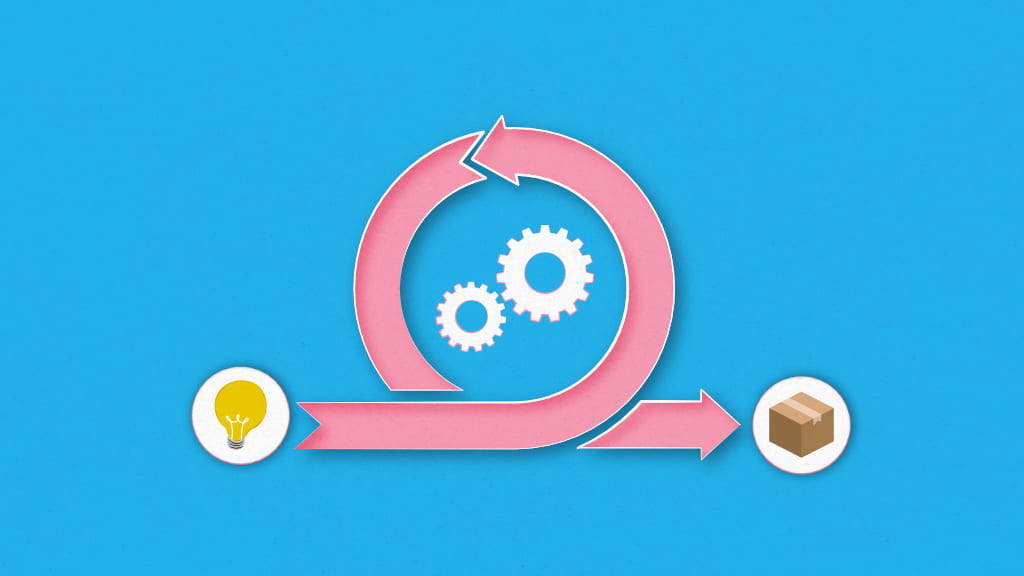Introduction
Agile project management, aka APM, is an iterative method of software development that focuses on each section or iteration to be reviewed and critiqued by the project team. The Agile method aims to shorten the phases in the software development process and increase the level of improvement.
What are the 4 agile values?
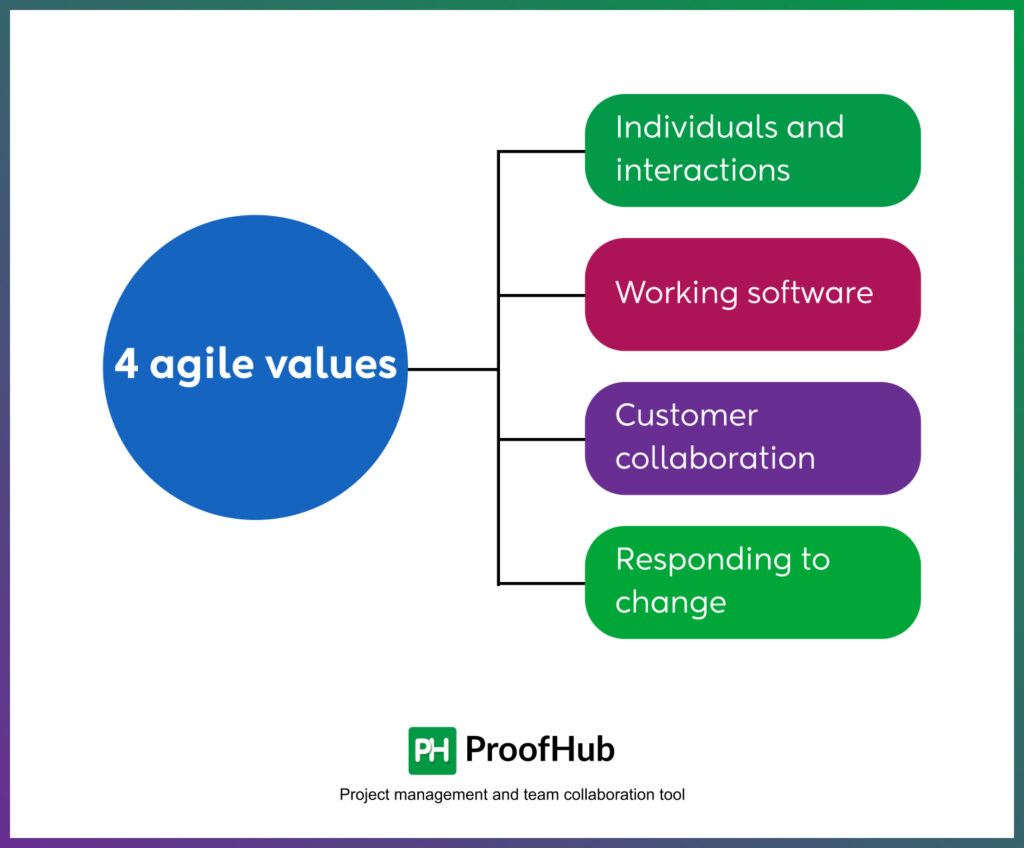
1. Individuals and interactions over processes and tools
“Individuals and interactions over processes and tools” is the first value in the Agile Manifesto. It refers to valuing individuals more highly than processes or tools because it is individuals who respond to the business/customer needs and take the process forward.
Tip: Make sure that communication is fluid and happens when a need arises.
2. Working software over comprehensive documentation
Software documentation is an important part of the Agile manifesto – but working software is even more important. The Agile approach focuses on streamlining data (technical specifications, technical requirements, technical prospectus, interface design documents, test plans, etc) so that the team can begin and keep up the pace at work without getting bogged down into the details.
Tip: Ditch manual software documentation and consider an automated file management system.
3. Customer collaboration over contract negotiation
Negotiation is when the customer and the manager/teams work out the details right before the project delivery. However, in the Agile Manifesto, the customer is not only engaged at the time of the final delivery. Instead, the Agile approach engaged and collaborated with the customer throughout the development process.
Tip: Engage and collaborate with the customer at intervals for periodic demos. Make sure that your customer becomes an essential part of the daily process, thereby ensuring that you meet the needs of the customer.
4. Responding to change over following a plan
Traditionally, change was seen as an added expense, so it was to be avoided. However, in the Agile manifesto, change is seen as a potential opportunity to improve, and develop better results.
Tip: Review your plans, priorities, and dependencies after a regular interval of time. Consider using automated project planning software or Gantt chart software.
Traditional project management vs. agile project management?
1. Flexibility
Traditional project management: There is little to no scope for changes. It only follows a rigid top-down approach. Once the plan is made, everyone sticks to it in the best possible manner.
Agile project management: The approach is more adaptable and offers a lot of flexibility in terms of making changes. People are free to communicate and experiment with the best alternatives for doing things.
2. Ownership and transparency
Traditional project management: The ownership belongs entirely to the Project Manager. It is entirely a manager’s responsibility to plan, implement, and monitor everything. Simply put, the managers hold all the reins of the project and the team members usually don’t have a say in any aspect of the project.
Agile project management: Managers, team members, and customers share the same level of ownership of the project. Everyone puts their heads together to plan and finish the project within the estimated time and budget.
3. Problem-solving
Traditional project management: In case there is an obstacle or issue, team members need to approach the manager for resolution. This causes undue delays and increases the overall cost as well.
Agile project management: Teams have the authority to make decisions on their own in the case of an obstacle. They can solve all issues internally, thereby avoiding wasting time. However, in the need to make extreme decisions, team members can consider the need to escalate to their manager.
4. Checkpoints and monitoring progress
Traditional project management: Heavy planning is needed at the analysis and design stage of the project. The entire focus is on streamlining the processes rather than on the product itself. The team follows a step-by-step, predefined process with minimal guidance—with no frequent check-ins.
Agile project management: Team members are encouraged to have checkpoints at regular intervals. They hold daily stand-ups to share updates on what was the work done, what obstacles were faced on the way, how they were dealt with, and what needs to be done tomorrow.
Also read: Traditional vs Agile project management method: Which one is right for your project?
What are agile project management principles?
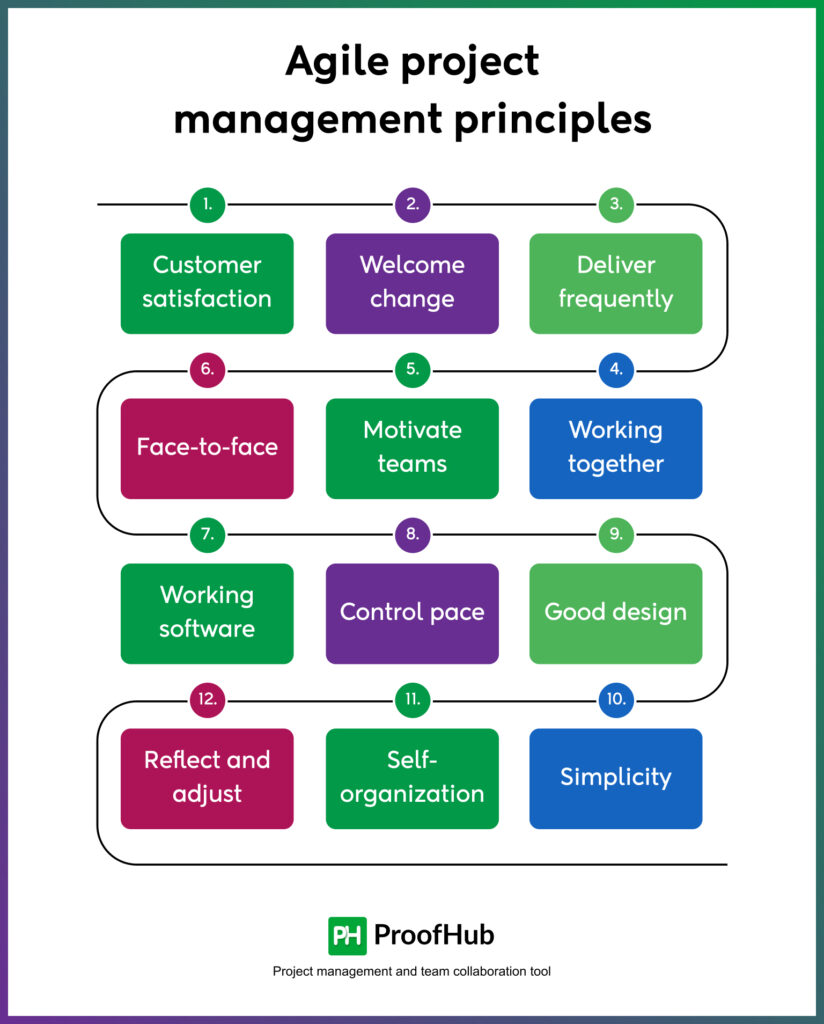
The 12 principles of Agile development include:
- Customer satisfaction through early and continuous software delivery.
- Welcome change regarding requirements throughout the project management process.
- Deliver frequently in the form of software sprints and iterations.
- Working together by ensuring continuous collaboration between business stakeholders, managers, and team members throughout the project.
- Motivate teams so that they are more likely to deliver their best work than unhappy teams.
- Face-to-face interactions make communication more successful, especially when the teams are co-located.
- Working software serves as a primary measure of progress to the customer.
- Control pace to ensure consistent development.
- Good design and attention to detail enhance agility and ensure that teams constantly improve the product and sustain change
- Simplicity of developing just enough to get the job done at the moment (but without compromising the quality).
- Self-organization encourages teams to have decision-making power, take ownership, communicate regularly, and deliver quality products.
- Reflect and adjust to become more effective and work more efficiently, together.
What are the 5 phases of agile project management?
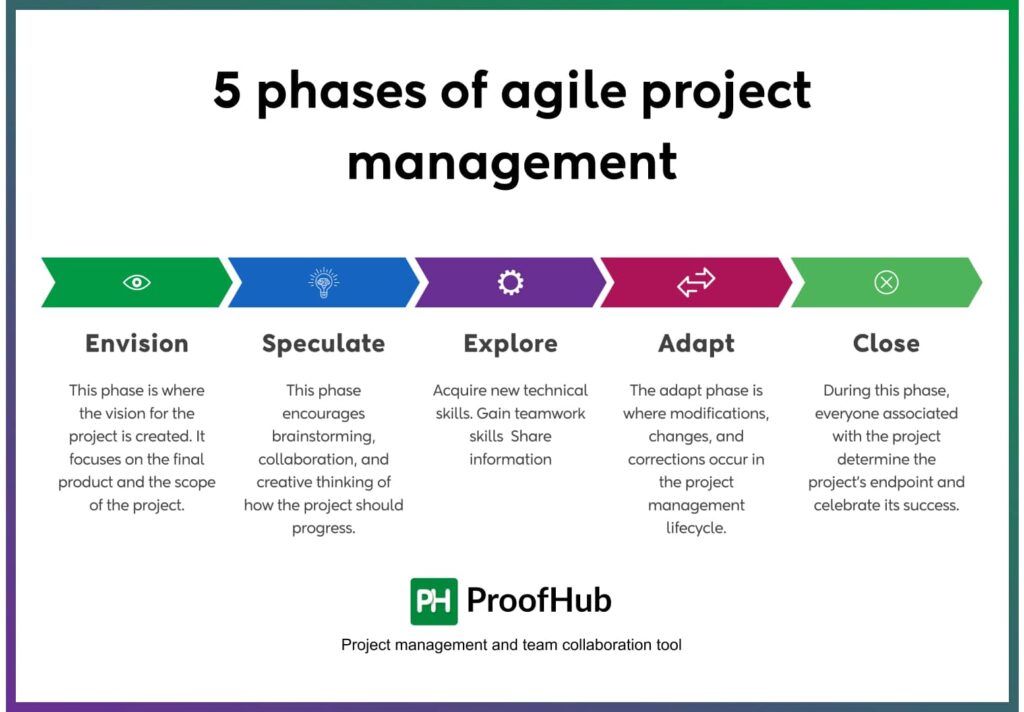
Agile project management is an amazing phenomenon that occurs in five major phases:
Phase 1: Envision
This envision phase is where the vision for the agile project is created. It covers What, Who, When, and How getting the project delivered is concerned. The phase focuses on the final product and the scope of the project.
Phase 2: Speculate
The next phase is speculation. This phase encourages brainstorming, collaboration, and creative thinking of how the agile project should progress. This is where people involved in the project discuss what’s possible to achieve and what’s out of reach—while also allowing enough flexibility to CHANGE if necessary.
Phase 3: Explore
The explore phase simply focuses on delivering project features.
In this phase, there are three crucial steps included:
- Managing the workload using the proper technical practices and risk management strategies to deliver what’s planned.
- Creating a self-organizing and collaborative community that shares responsibility facilitated by the project manager.
- Managing how team members interact with each other and other parties (customers, product managers, stakeholders, etc).
Phase 4: Adapt
In the adapt phase, modifications, changes, and corrections occur in the project management lifecycle. This phase is designed to analyze the actual results versus planned results. More importantly, consider the improvements needed and re-planning the approach for the upcoming iteration.
Phase 5: Close
And here comes the final phase. During this phase, everyone associated with the project determines the project’s endpoint. But before they put an end to the project, they analyze, and review all the key aspects of the project to make sure that they deliver exactly what’s expected of them.
How ProofHub can help you in agile project management?
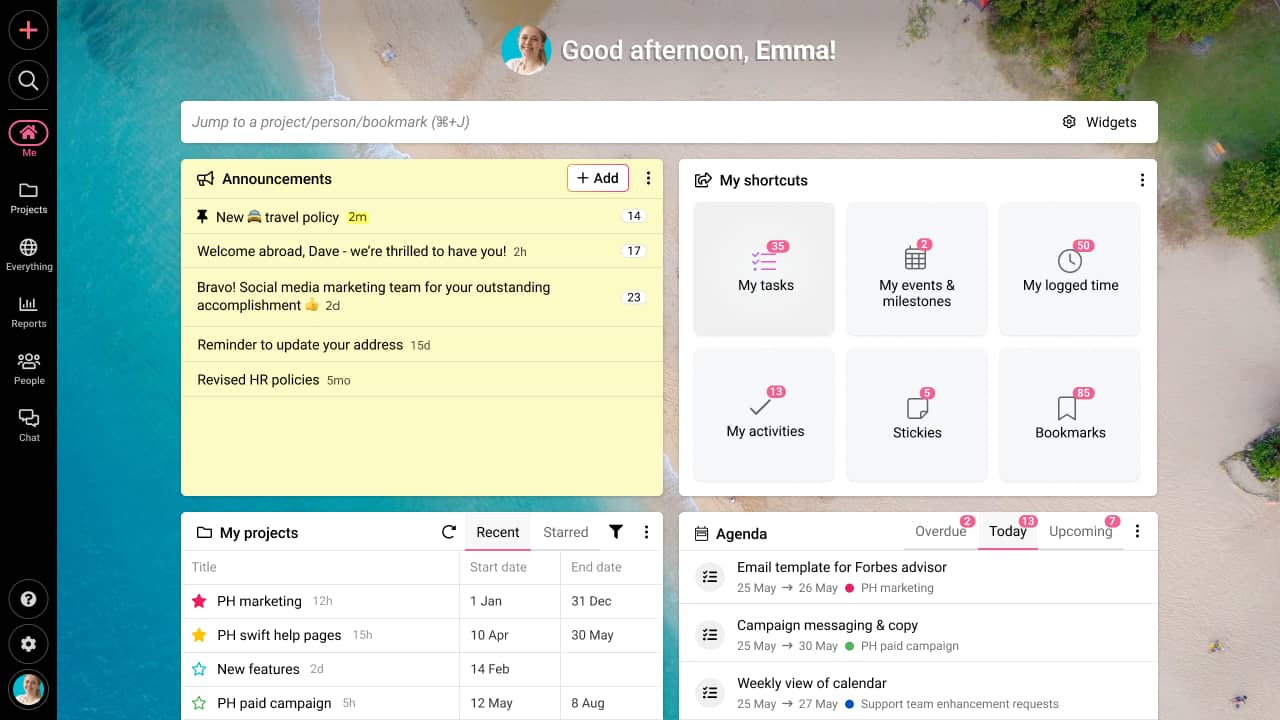
In simple words, ProofHub is the best of both worlds.
ProofHub is a smart full-fledged Agile project management software used by leading organizations. It is packed with all the features that you and your team may need to plan, collaborate, and organize.
Teams can effortlessly share ideas, compile documents, start discussions, and move forward with this collaborative tool. The software combines the benefits of both traditional project management style and Agile methodologies—and provides those benefits to growing teams and businesses under one roof.
A feature for all your project management needs
1. Tasks
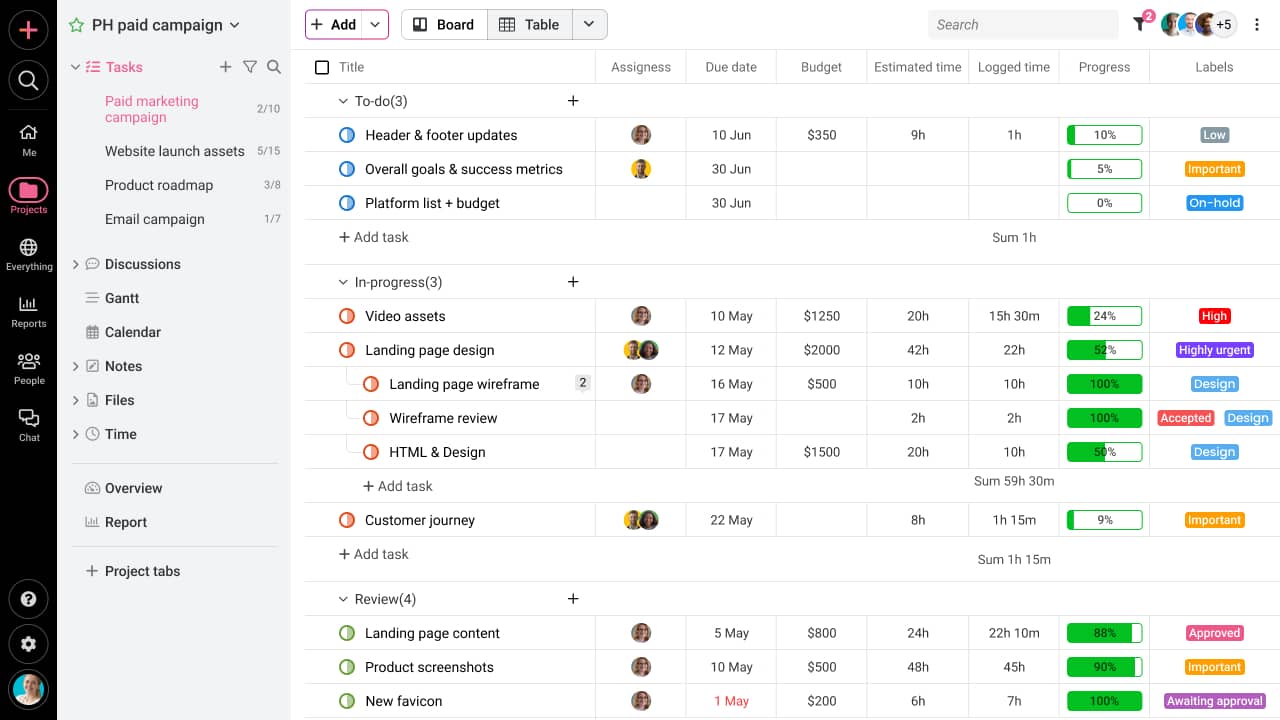
Who will be working on what and who has worked on which tasks in agile software development? This is where the value of ProofHub shines.
ProofHub tasks allow you to assign and prioritize agile tasks to one or as many team members as you want. You can also break the tasks into smaller and manageable subtasks and select the assignees for each subtask too.
You can set start and due dates and define clear deadlines for agile software development projects, as long as the prioritization of tasks is concerned.
In ProofHub, you can set a task to recur if it needs to be done regularly without having to create it manually yet and again.
You can also @mention people in task comments to address them, grab their attention, or loop them in. You can add tasks to ProofHub with email-in without any particular format. The title of the task will be the subject of your email and the email body will become the description of the task.
ProofHub offers a task management feature to manage agile tasks and achieve goals faster. What else?
- Assign tasks to ensure a clear distribution of responsibilities
- Break down tasks into smaller and more manageable subtasks
- Add custom labels to prioritize and organize tasks
- No need to manually add tasks that need to be done regularly
- Email-in tasks to add tasks directly without having to log in on ProofHub
- Track time spent on tasks manually or using a timer
- Restrict your account access to only those IP addresses that you want
- Filters to view tasks later, anytime, due in the past, no date set
- Limit visibility of tasks only to the people who are assigned
- Add comments, emojis, and files on each task
- Import tasks in your tasklist – CSV file
2. Discussions
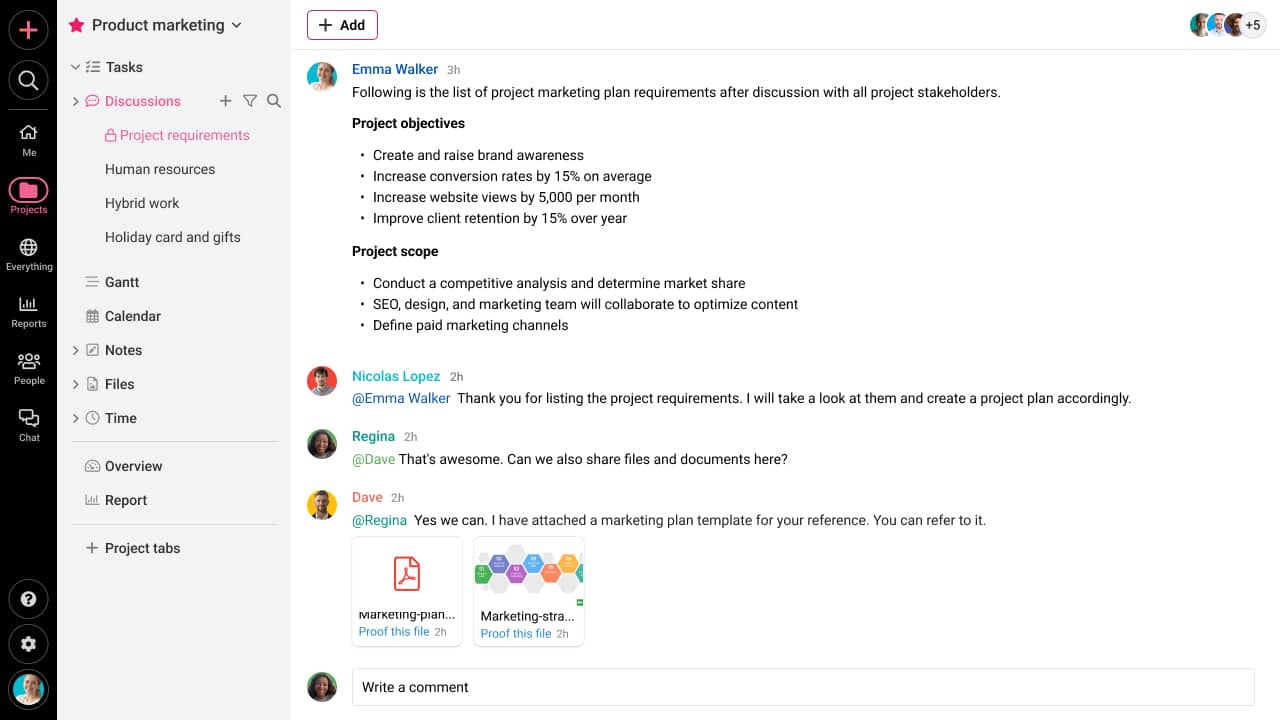
ProofHub Discussion is an online collaboration platform to bring your agile team and client discussions in one place.
While working on agile projects, teams can create discussion topics that focus on a particular matter. While creating a topic, you can bring your team and client discussion to one place. Mark your discussion private whenever you want to.
Furthermore, you can add comments, and @mention people to grab the clients’ or teams’ attention or loop them in an ongoing conversation, proof designs, and share ideas, files, and documents without having to go back and forth in long emails.
You can subscribe topics to specific people with whom you want to have discussions. It gives a great way to communicate in comments to share ideas, inputs, or feedback in a conversation thread on a particular discussion topic.
No more digging through emails to find specific topics or suggestions from your team. What are the major features?
- Use emojis to add fun to your discussions and express whenever you are short of words
- Embed images or files on your topic from your computer, Box, Dropbox, Google Drive, and OneDrive to your comments or drag and drop files when you create a discussion topic
- Proof designs and documents and collaborate on them
- Use email-in to add comments on discussion topics without logging in to your ProofHub account
- Advanced search to look for discussion topics using specific keywords
- Archive discussion topics anytime and see it later whenever you want to
- Collaborate quickly using the @mention feature and grab anyone’s attention to take them in the loop
- Share feedback or inputs in the conversation thread by adding comments
- Pin a discussion topic to the top to highlight it and make it easily accessible
- Manage people you subscribe to each topic of discussion
3. Kanban Boards
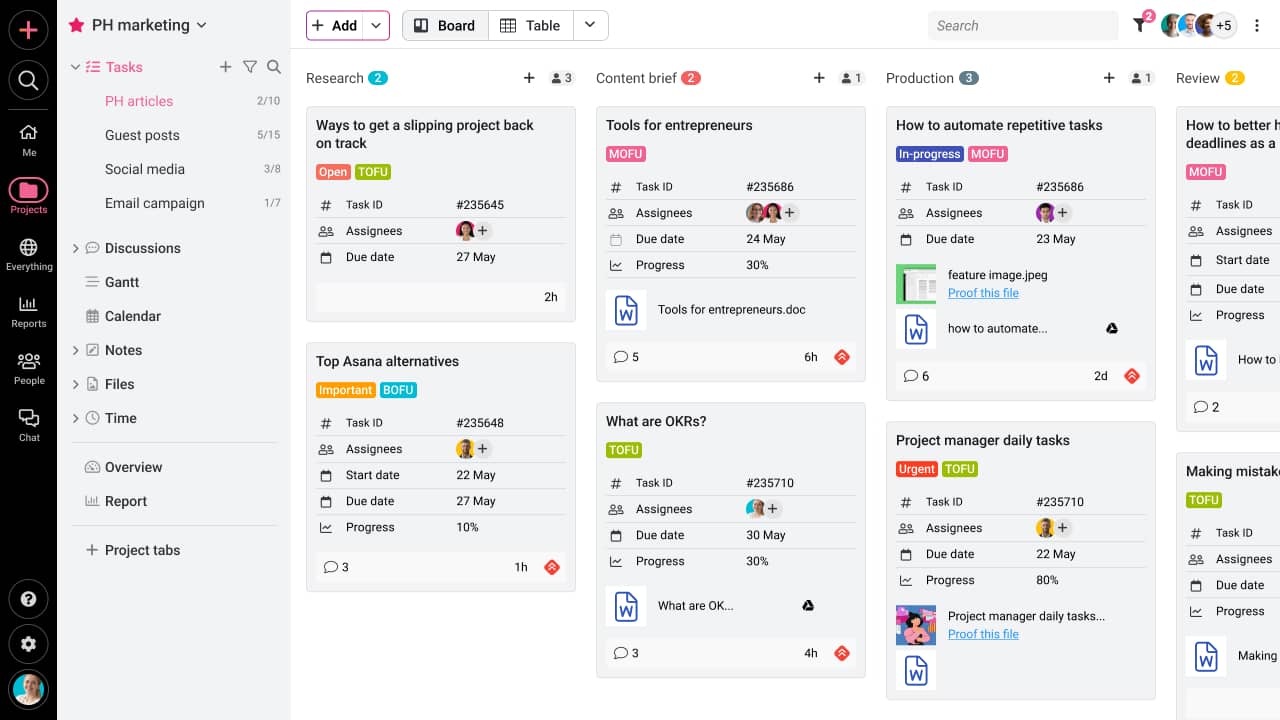
Kanban board in ProofHub is quite popular among remote and in-house teams to manage workflows and agile projects – who is supposed to do what, and what is the progress of projects? It is good for visualizing stages of tasks and to track progress.
One can get a clear view of work in progress as the team drags tasks from one stage to the other right on the board. It empowers teams to self-manage with a better understanding of workflows. When the tasks are moved from one stage to another, assignees of the tasks also get notified.
The basic structure of the Kanban board online has three columns: to-do, in progress, and done.
- Visualize workflow: Create a visual model of your team’s workflow to see who is doing what and who is supposed to do what
- Custom workflows: Create custom workflows and choose whom to subscribe to each stage of the workflow
- Eliminate long meetings: Keeps everyone in the loop to work together, add comments, files, and documents
- Spot bottlenecks: Teams can spot problems if anyone missed a due date or is losing track of workflow
- Add tasks and subtasks: Add a subtask to a task in the task list, add a due date to the subtask, and also add multiple assignees
- Easy and simple filters: You get to view your tasks through the filter.
- Import tasks: Import a CSV file and fill your data at once
- Multiple stages: Move your task from one stage to another as you complete them
- Task history: A track of created the task and who made any changes to the tasks
- Bookmarks: Add task lists to bookmark to access it from wherever you are
- Copies of task lists: Create copies of task lists to reuse them anytime
4. Gantt Charts
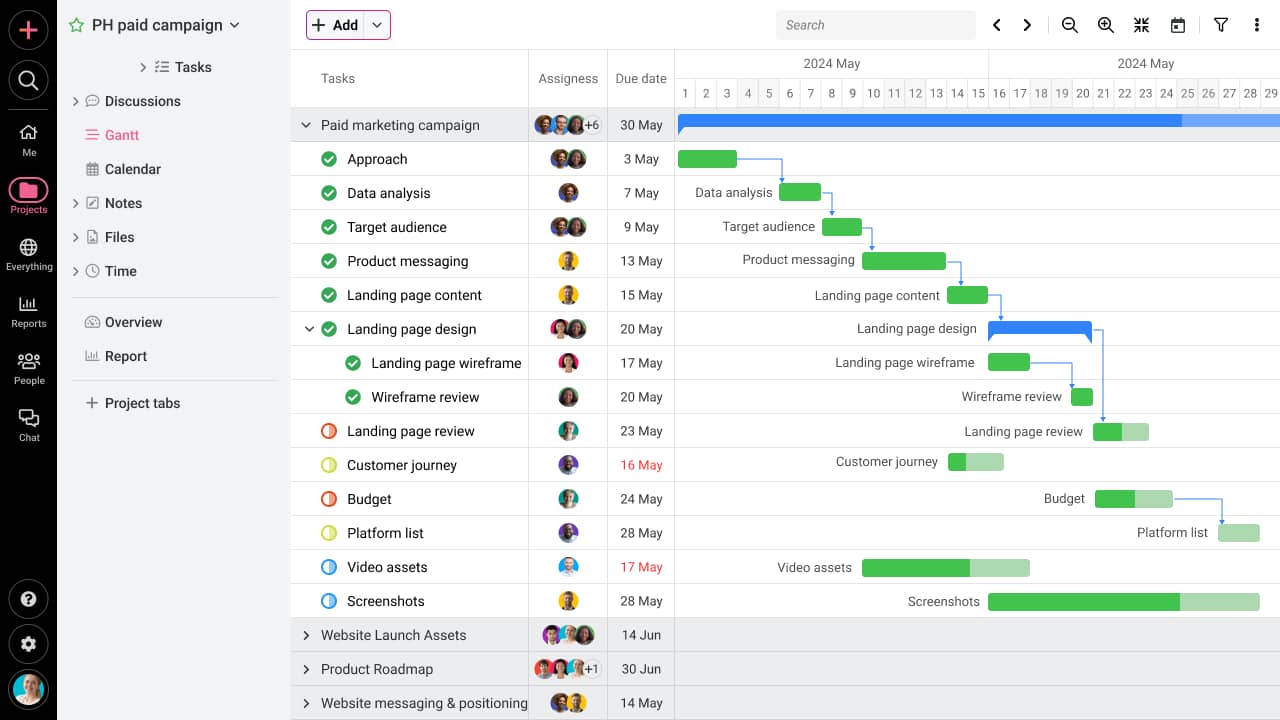
Do you often have to tell your team members about their tasks and deadlines? Are you struggling to figure out who is responsible for what part of the agile software project?
Finishing an agile project on time and within the budget is every manager’s goal. A Gantt chart is a visual view of projects and associated resources over time. The useful graphical tool shows activities or tasks done against time to know what part is to be done and when.
ProofHub Gantt charts are used by agile teams for planning projects and staying on top of the schedule of every task. For example, a marketing campaign can easily turn into chaos if its teams and tasks are not managed properly.
Gantt charts in ProofHub let you plan and schedule the order in which you want to complete agile tasks and visualize them in a timeline view. Setting dependencies between tasks is helpful when it becomes a challenge to adjust plans as deadlines shift. You just need to integrate the Gantt chart tool into your current process to manage tasks and projects more smartly.
ProofHub’s Gantt chart offers:
- Visual timeline to have a centralized view of all the tasks in one place.
- Task dependencies to understand how changing the schedule of a task can influence the progress of other tasks in the task list.
- Real-time progress tracking to have a real picture of the progress made in tasks by each team member.
- Drag and drop tasks to promptly change their start or due dates.
- Critical chain to identify the status of tasks that can impact the overall project progress and make changes to get them delivered on time.
- Email-in to add tasks in the Gantt chart via email without having to log in to your ProofHub account.
5. Calendar

Calendar in ProofHub is good for organizing and scheduling events and milestones all in one place. It gives automatic reminders for events and milestones, recurring events, and tasks. It lets you organize all your agile software development tasks, milestones, and events happening within the project in one place.
The all-new calendar view gives all the options to see a day’s tasks on the calendar, check the events for the next 2 weeks, and check the milestones set for a month. You can do more with ProofHub calendar: select your calendar view from day, week, 2 weeks, or even a month and schedule work suitably, add private milestones and events, and see all data of your project in one place.
You can set automatic reminders for your events and milestones and thus stay on top of your schedule. Create milestones, for example, ‘Complete content production’ to mark key dates in a project, and save the dates for events like ‘Share the content for publishing’. You can also subscribe to your ProofHub calendar to any calendar that you generally use and get work schedules merged in one place. And what else?
- Recurring events/tasks without creating an event or task manually again
- Stay on top of your agile schedule by setting automatic reminders for your events and milestones
- Select your calendar view from day, week, 2 weeks, or even a month
- Add private milestones and events to limit their visibility to the people you want
- Bird’s eye view for all calendars without having to jump through projects
- Download calendars in PDF, CSV, or iCal formats
- Pull information from your ProofHub calendar into your external calendar
6. Custom Roles

Because privacy is always an issue when using project management software. But when using ProofHub, you need not worry. You get ultimate control over what you do with ProofHub.
Custom roles are good for defining access levels for agile software development teams and clients. You can create custom roles to choose who sees what and manages what.
Give permission to team members, clients, or stakeholders for each section that suits your workflow and allow them to do things as per their responsibilities. Also, you can revoke access to the sections you don’t want certain users to see.
For example, you want to assign roles to team members on your agile project. You get to add someone as a manager, client, trainee, or executive. Also, grant access levels to each. This way you choose what you want people to view, add, and manage in ProofHub according to your organizational workflow. You can also revoke access to the sections you don’t want certain people to see or get permission to use. All-in-all, here’s what all you can do:
- Create custom roles and decide the permission for each section how it suits you
- Assign custom roles as an administrator to the team members or clients as per their work and responsibilities
- Grant access level to each user to view, add, and manage in ProofHub
- Revoke access to the sections you don’t want certain users to get permission to use
- Assign default roles such as Normal user or Admin to the team members
7. Proofing
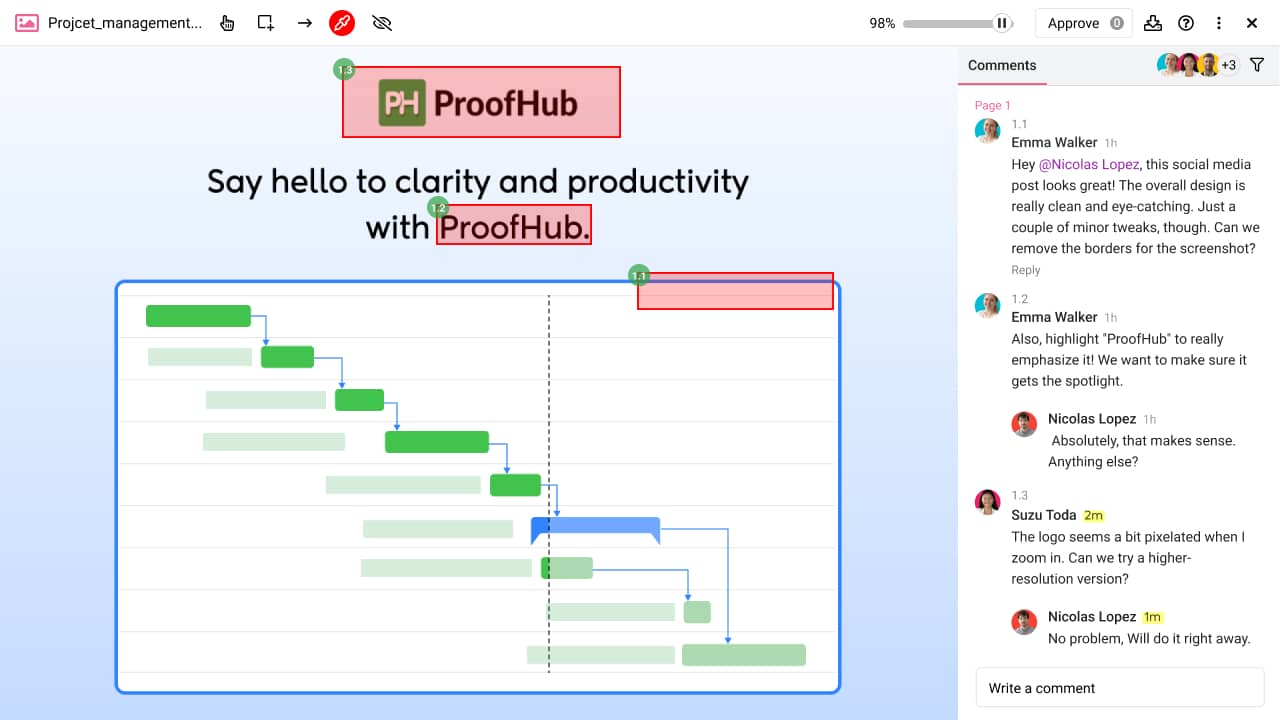
Are you still following the time-consuming method of review and approval? The manager forwards the design to the senior person. The senior person finds faults and then the email is again sent to the designer. The designer makes the changes. The manager approves it. The manager shares it with the client. The client doesn’t like it. It goes back and forth through emails to make the changes.
And you can well imagine, it consumes a lot of time and energy. And it is equally frustrating for everyone involved in the design process. No matter what, you need a tool that can bring everything to one place so you are saved from checking email back and forth.
With an online proofing tool like ProofHub, you can instantly make changes to your design. ProofHub has an in-built proofing tool to collaborate on the designs and review them right away from any number of people in one place.
Annotate files with markup tools to bring changes to specific regions. You get the option to comment and reply to comments within a thread that focuses on quick feedback. The best part is you can upload versions of files to compare it with the previous version to review changes.
Have a look at what you can do with ProofHub’s proofing tool:
- Collaborate on designs & documents in real time
- Review and add comments to share feedback in one place
- Annotate files with markup tools
- Add clear and actionable feedback for specific regions
- Reply to comments within a thread
- Upload new versions of files and compare them with the previous versions to review changes
- Mark suggestions or feedback as resolved once the changes are made
- One-click approval to resolve all suggested changes and feedback
8. Request Forms
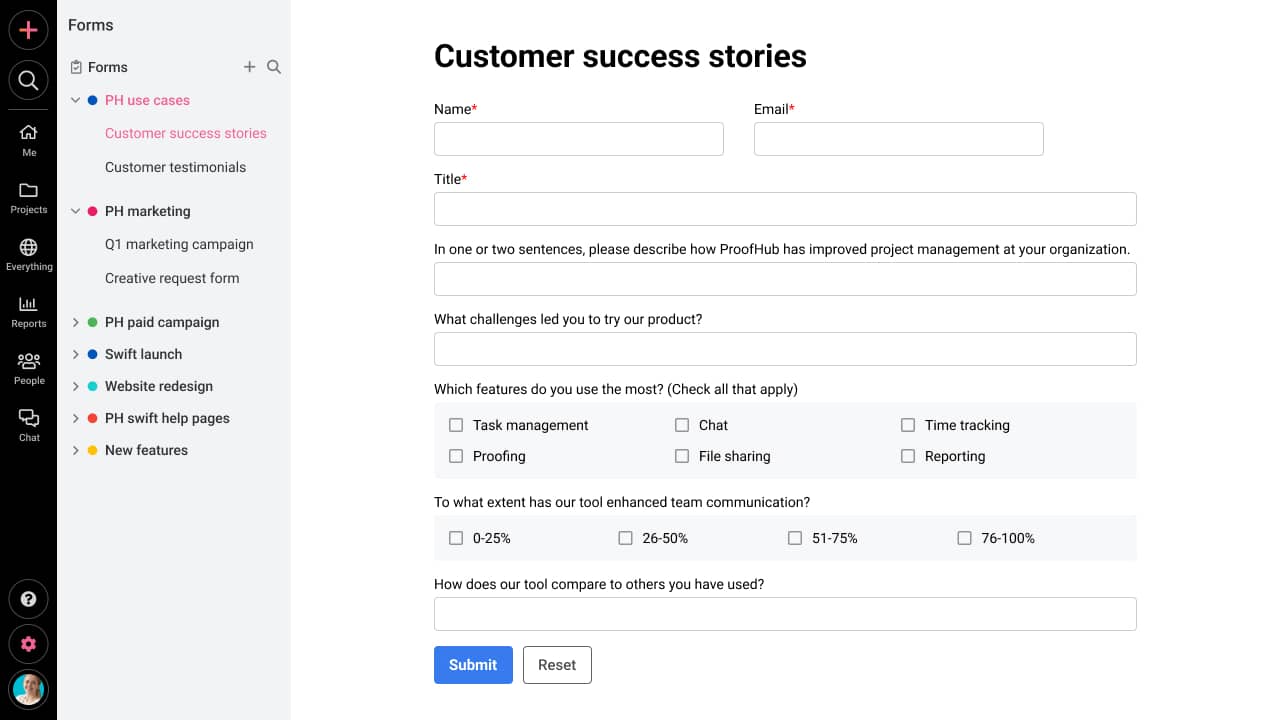
Work requests can be annoying and can come at any time. If you have a smarter and easier way to manage requests, it can centralize, prioritize, and manage all of the requests your team receives.
If you’re looking for an easier way to take work requests through a form, ProofHub’s request form is the solution for you. ProofHub understands the clutter in your inbox with requests for work, support queries, or tickets.
Manage your requests for support queries, tickets, product requests, or any work requests, with request forms in ProofHub.
As per your needs, you can customize the fields of your choice in the request form to get the information you require and never miss a requirement again. You can use the form as it is or you can edit the HTML code to add customized fields of your choice. It lets you do a lot.
- Add request forms in ProofHub for different projects with labels of your choice
- Get requests added directly to ProofHub by pasting the link of the form from anywhere you want
- Customize request forms to get the information you require to get started
How do you know if agile is right for your team
Everything we have shared so far sounds great on the surface, but Agile project management doesn’t work on all projects. So, before you get into the specifics of applying Agile to your existing project management system, let’s take a bit of a deeper dive.
“Agile” means moving quickly. That means not everything or every aspect of your project will be planned. Therefore, you need to be sure about whether or not your business, your projects, and your team can handle this Agile change. To do that, here are a few important questions you need to ask and answer:
1. Are you ready to start a project without knowing where it will end up?
Before you adopt Agile, ask yourself if you and your team are comfortable putting out a less-than-finished version of your product/project to test. or do you people think your project/product needs to be fully completed before it sees the light of day?
2. How much risk are you willing to manage?
As we said, Agile is all about continuous change and making improvements by learning from your mistakes. This means you will be putting your projects at a higher level of risk than you would if you were relying on traditional project management.
3. How flexible is your team?
In Agile, you work with your customers to make the product better. But this doesn’t always fly with designers, developers, and makers of all kinds with an ego (i.e. all of us). Ask yourself if your key players can put their egos aside and adjust their efforts and ideas based on customer needs.
4. What can you say about your company’s hierarchy?
Agile isn’t just about working with your customers. It’s also about providing key access to customers daily. It might be a stretch for your business, depending on the type of company culture or company hierarchy you have. So, make a wise decision.
5. How do you measure progress and success during project management?
Agile project management is all about continuously refining your processes and delivering something better. So, take a moment to evaluate how you define progress and success.
So, here is almost everything you need to know to get started with Agile project management. Hope this post helped you make your existing process faster, smarter, and more effective.
Related articles:
